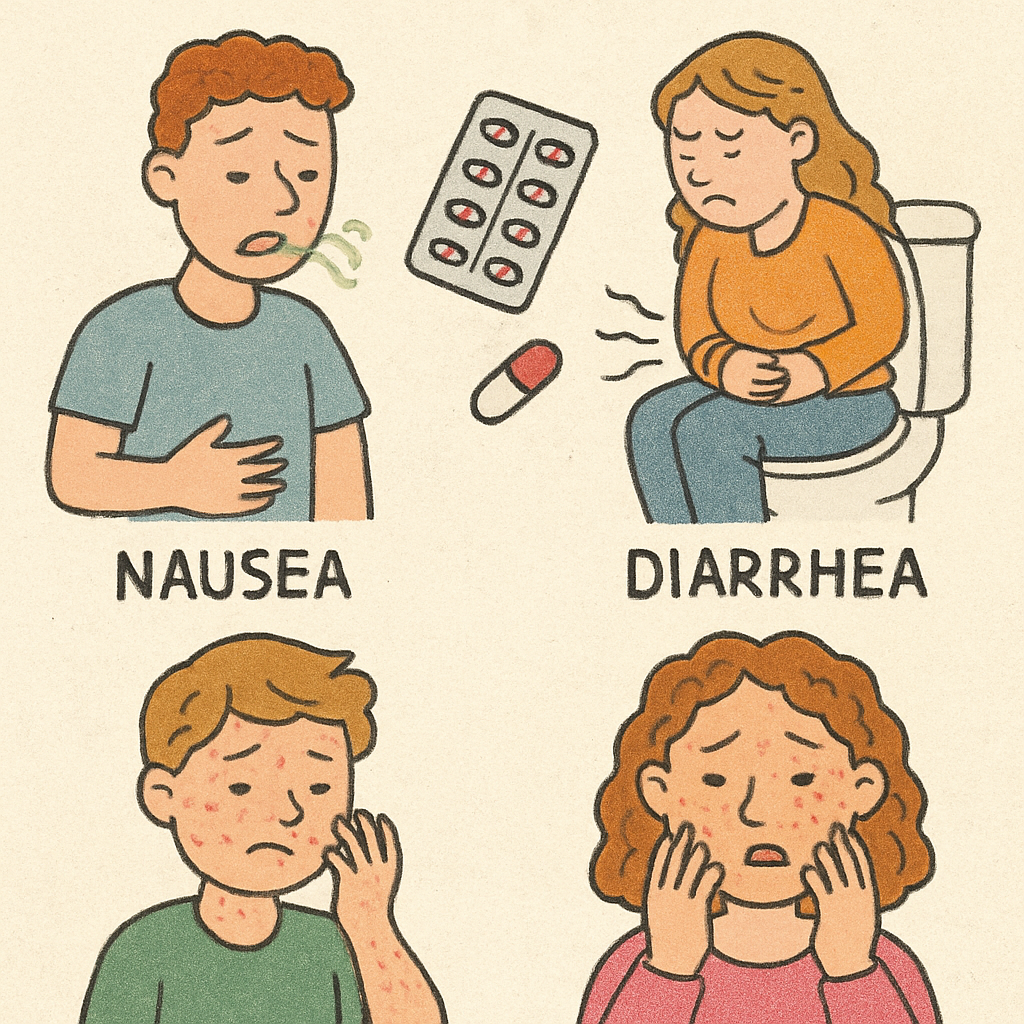
Green and white capsule antibiotics are a specific form of medication used to treat bacterial infections. The coloration of these capsules is not indicative of a particular type of antibiotic but is rather a choice made by manufacturers for branding and identification purposes. Within these capsules lie active ingredients that effectively combat bacteria, aiding in the treatment of infections and curbing the spread of bacterial pathogens.
The Role of Color in Medication
The color of medication, including green and white capsules, primarily serves a practical purpose. It helps in the easy identification and differentiation of medications, not only for healthcare professionals but also for patients. Color coding can prevent medication errors, ensuring that patients receive the correct prescription. While it might not have a pharmacological impact, the color can enhance compliance by making the medication visually distinct.
Active Ingredients in Green and White Capsules
The active ingredients in these capsules are designed to target and eliminate specific bacteria. These ingredients vary depending on the type of antibiotic and its intended use. For instance, some capsules might contain broad-spectrum antibiotics, which can tackle a wide range of bacteria, while others might be narrow-spectrum, focusing on specific bacterial strains. Understanding these ingredients is crucial for grasping how they work to combat infections.
Branding and Identification
Branding plays a significant role in the pharmaceutical industry, and the color of capsules is often part of a broader branding strategy. This can include not just the color but also the shape and size of the capsule. For patients, this branding helps in recognizing the medication, ensuring that they adhere to their prescribed regimen. For healthcare providers, it aids in quickly identifying the medication, streamlining the dispensing process.
Common Green and White Capsule Antibiotics
There are numerous antibiotics available in green and white capsules, each with its own specific applications. Some of the most frequently prescribed ones include:
Amoxicillin: Versatile and Widely Used
Amoxicillin is a commonly prescribed antibiotic that falls under the penicillin class. It’s often used to treat a variety of infections such as ear infections, respiratory infections, and urinary tract infections. Its effectiveness and mild side effect profile make it a go-to choice for many healthcare providers. Patients are advised to adhere strictly to the dosage instructions to ensure optimal results.
Cephalexin: Targeting Skin and Bone Infections
Cephalexin belongs to the cephalosporin class of antibiotics and is particularly effective against skin infections, bone infections, and certain types of pneumonia. It’s known for its ability to disrupt the formation of bacterial cell walls, which ultimately leads to the destruction of the bacteria. Patients taking cephalexin should be aware of potential allergic reactions, especially if they have a history of penicillin allergies.
Clindamycin: Combatting Severe Infections
Clindamycin is typically reserved for more severe infections, especially those caused by anaerobic bacteria. It’s often used when other antibiotics are ineffective, making it a critical tool in serious medical situations. Clindamycin can sometimes cause gastrointestinal side effects, so patients are advised to take it with food and report any severe side effects to their healthcare provider.
How Do Antibiotics Work?
Antibiotics function by targeting the bacteria responsible for infections. They either kill the bacteria outright or inhibit their ability to multiply, allowing the body’s immune system to eliminate the remaining bacteria. Completing the entire course of antibiotics is paramount, even if symptoms improve, to ensure that all the bacteria are eradicated.
Mechanisms of Action
Different antibiotics have distinct mechanisms of action. Some, like penicillins, disrupt the construction of bacterial cell walls, leading to cell death. Others, such as tetracyclines, inhibit protein synthesis within the bacteria, preventing them from reproducing. Understanding these mechanisms helps in appreciating how antibiotics can be specifically tailored to different types of bacterial infections.
Importance of Completing the Course
One of the most critical aspects of antibiotic use is completing the prescribed course. Even if you start to feel better, stopping early can lead to the survival of some bacteria, which may develop resistance. Completing the course ensures that all bacteria are eliminated, reducing the risk of recurrence and resistance.
Immune System Support
While antibiotics are powerful tools against infections, they also work in tandem with the body’s immune system. By reducing the bacterial load, antibiotics make it easier for the immune system to clear the infection. This synergy is crucial for a full recovery, highlighting the importance of maintaining a healthy immune system alongside antibiotic treatment.
Types of Bacteria Antibiotics Target
Antibiotics are engineered to target specific types of bacteria, and choosing the right one is critical for effective treatment. Broad-spectrum antibiotics can address a wide variety of bacteria, while narrow-spectrum antibiotics focus on specific types. Doctors select the appropriate antibiotic based on the nature of the infection and the bacteria involved.
Broad-Spectrum vs. Narrow-Spectrum
Broad-spectrum antibiotics are versatile, able to target a range of bacteria, making them useful when the specific bacteria causing an infection are unknown. However, they can also disrupt the body’s normal microbial flora. Narrow-spectrum antibiotics, on the other hand, are more targeted, minimizing collateral damage to beneficial bacteria. The choice between the two depends on the specific clinical scenario.
Identifying the Infection
Accurate identification of the bacterial infection is crucial for effective antibiotic therapy. This often involves laboratory tests that can determine the specific bacteria and their susceptibility to different antibiotics. Such diagnostics enable healthcare providers to prescribe the most effective treatment, minimizing the risk of resistance and ensuring a swift recovery.
Personalized Antibiotic Therapy
Personalized antibiotic therapy involves tailoring the antibiotic choice and dosage to the individual patient’s needs. Factors such as the patient’s medical history, allergies, and the nature of the infection all play a role in this decision-making process. This personalized approach not only enhances the effectiveness of treatment but also reduces the risk of adverse reactions.
Side Effects and Considerations

While antibiotics are generally safe, they can cause side effects. Some individuals may experience nausea, diarrhea, or an allergic reaction. It’s vital to inform your doctor about any allergies or past reactions to medications to mitigate risks.
Gastrointestinal Issues: Nausea and Diarrhea
Gastrointestinal discomfort is one of the most common side effects of antibiotics. Nausea and diarrhea occur because antibiotics can disrupt the balance of good bacteria in the gut. To alleviate these symptoms, patients can take probiotics or consume fermented foods, which help restore healthy gut flora. Staying hydrated is also crucial in managing these side effects effectively.
Yeast Infections: A Common Complication
Some antibiotics can lead to an overgrowth of yeast, resulting in infections like thrush or vaginal yeast infections. This happens because antibiotics can disrupt the balance of microorganisms in the body. Patients prone to yeast infections should discuss preventive measures with their healthcare provider, such as using antifungal treatments or probiotics during and after antibiotic therapy.
Allergic Reactions: Recognizing the Signs
Allergic reactions to antibiotics can range from mild rashes to severe, life-threatening conditions like anaphylaxis. It’s crucial for patients to be aware of their allergy history and communicate any known allergies to their healthcare provider. In case of a severe reaction, immediate medical attention is necessary, and alternative antibiotics may need to be considered.
Importance of Proper Use
Using antibiotics correctly is crucial for their effectiveness and to prevent antibiotic resistance. Here are some essential tips for proper use:
Follow Prescribed Dosage: Adherence is Key
Taking medication exactly as prescribed is vital for achieving the desired therapeutic outcome. Skipping doses or discontinuing treatment prematurely can lead to treatment failure and the development of resistance. Patients should maintain a consistent schedule, and if a dose is missed, they should consult their healthcare provider for advice on how to proceed.
Avoid Sharing Medication: A Personalized Treatment
Antibiotics are prescribed based on individual medical conditions and bacterial susceptibility. Sharing antibiotics can be dangerous, as the same medication may not be suitable for another person’s infection. Additionally, inappropriate use can contribute to the development of resistant bacteria, making future infections harder to treat.
Store Properly: Preserving Potency
Proper storage of antibiotics is essential to maintain their effectiveness. Medications should be kept in a cool, dry place, away from direct sunlight and moisture, which can degrade the active ingredients. Patients should also be mindful of expiration dates, as expired antibiotics may not only be ineffective but also potentially harmful.
Antibiotic Resistance: A Growing Concern

by National Institute of Allergy and Infectious Diseases (https://unsplash.com/@niaid)
Antibiotic resistance occurs when bacteria evolve and become immune to the effects of an antibiotic. This phenomenon often results from the overuse or misuse of antibiotics and poses a significant public health threat as it renders infections harder to treat.
How Bacteria Develop Resistance
Bacteria can develop resistance through genetic mutations or by acquiring resistance genes from other bacteria. This process is accelerated by the misuse of antibiotics, such as not completing a course or using antibiotics for viral infections. Understanding the mechanisms of resistance can help in devising strategies to curb its spread.
Global Health Implications
The rise of antibiotic-resistant bacteria is a global health crisis, leading to longer hospital stays, higher medical costs, and increased mortality. It threatens to reverse decades of medical progress, making previously treatable infections potentially lethal. International collaboration and stringent antibiotic stewardship are needed to tackle this pressing issue.
Strategies to Combat Resistance
Preventing antibiotic resistance requires a multifaceted approach. This includes educating the public about the appropriate use of antibiotics, implementing strict guidelines for antibiotic prescribing, and investing in the development of new antibiotics. Additionally, improving infection prevention and control measures can significantly reduce the spread of resistant bacteria.
When to Consult Your Doctor
Consulting a healthcare professional before starting or stopping any medication is crucial. They can provide guidance on the necessity of an antibiotic and select the appropriate one for your condition.
Discussing Your Infection
Open communication with your doctor about the nature of your infection is essential for determining the best treatment approach. This includes discussing symptoms, previous infections, and any known allergies. Such discussions enable your doctor to tailor treatment to your specific needs, ensuring safety and effectiveness.
Understanding Potential Side Effects
Understanding the potential side effects of antibiotics can help you manage them effectively and prevent complications. Your doctor can provide information on what to expect and how to mitigate common side effects. Additionally, they can advise on when to seek medical attention for severe reactions.
Handling Missed Doses
In the event of a missed dose, it’s important to seek your doctor’s advice rather than making assumptions. They can provide guidance on whether to take the missed dose immediately or wait until the next scheduled dose. Proper management of missed doses ensures the continued effectiveness of your treatment.
Conclusion
Green and white capsule antibiotics represent just one form of medication used in the fight against bacterial infections. Understanding their mechanisms, potential side effects, and the importance of proper use empowers patients to make informed healthcare decisions.
Always consult with your healthcare provider to ensure the safe and effective use of antibiotics. By doing so, you not only safeguard your health but also contribute to the global effort to combat antibiotic resistance, preserving the efficacy of these vital medications for future generations.

